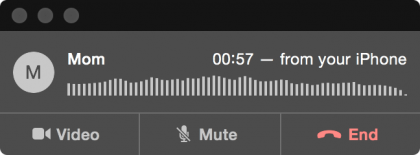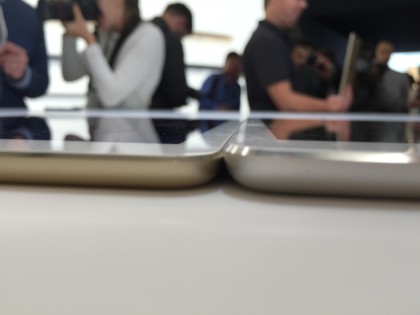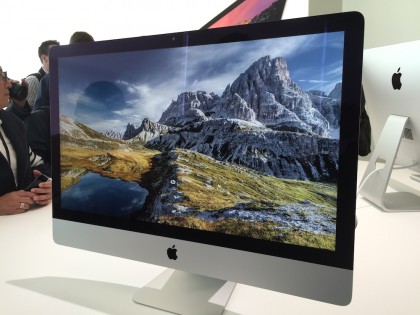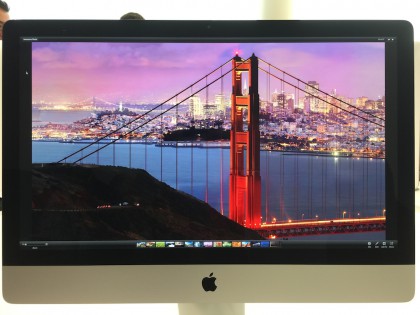October 19, 2014
Written by Dave Mark
Follow the link for a fantastic look at some of the technology behind Big Hero Six. For example, from about two minutes in:
One of the things that our boss, John Lassiter, encourages us to do is to try to find something that people have never seen before. So if you’re making a move with a robot, he’ll say, “Look at all the famous pop culture robots. Look at WALL-E, look at C-3PO, R2-D2, the Terminator, the whole list, and then come up with something that occupies its own air space.”
Brilliant.
Written by Dave Mark
Daniel Eran Dilger, writing for AppleInsider:
While still operating with full security measures in place—comically highlighted in assurances voiced by Stephen Colbert during the keynote to “triple down” on security—Apple is now working to share legitimate things for people to talk about rather than trying maintain an awkward silence between its product introductions.
The move follows a similar step by the company earlier this summer to invite roughly a dozen outside observers to experience WWDC, the company’s confab for developers that has previously been strictly limited to partners under Non-Disclosure Agreements.
Apple also opened up its WWDC session videos and actually encouraged its developers—and members of the media—to talk about the new technologies it was introducing, a marked departure from the days when even registered developers were advised not to say anything about anything, even to other developers.
The result has been nothing short of spectacular. Even people who don’t know C# from Shinola know about Swift, the new language Apple introduced at WWDC. APIs and initiatives from Metal to CarPlay and HomeKit to HealthKit are now familiar terms even to many non-technical people, despite being just a few months out of the gate.
Thoughtful read, resonates with me. The old policy caused a tremendous amount of stress for developers, hamstrung in their attempts to crowdsource solutions to bugs in beta releases of iOS and the iOS SDK, or just to figure out how to make the newest kit work properly.
On a more personal note, trying to write a book about upcoming revs of the SDK was fraught with communication roadblocks. As an example, when Jeff LaMarche and I were working on our very first iPhone development book, the first rev of the iPhone SDK had not yet been publicly released. Because everything was behind an NDA, there was lots we could not talk about, including the very important steps required to connect your code to an actual device (instead of running it in the simulator). All the details were hidden behind the official developer portal. This was terribly useful information, not particularly well documented (at least back then), and exactly the sort of thing that a how-to book should be laying out in detail. Which we were prevented from doing.
This is just one tiny example of the frustration of Apple’s rigid tight-lipped former policy. I love the new approach. One highlight for me was the incredibly humanistic way that Apple acknowledged the accidental release of information about the new iPads before Thursday’s keynote. Bringing Stephen Colbert on board as the Supreme Commander of Secrecy was genius. That move added to the brand, added to the likability of Apple as a company.
October 18, 2014
Written by Dave Mark
If you are at all a Bill Murray fan, this is a real treat. An hour and thirteen minutes of Bill being Bill. Delicious.
Written by Dave Mark
Judith Newman, writing about an autistic boy named Gus and his BFF, Siri:
Gus had never noticed Siri before, but when he discovered there was someone who would not just find information on his various obsessions (trains, planes, buses, escalators and, of course, anything related to weather) but actually semi-discuss these subjects tirelessly, he was hooked. And I was grateful. Now, when my head was about to explode if I had to have another conversation about the chance of tornadoes in Kansas City, Mo., I could reply brightly: “Hey! Why don’t you ask Siri?”
It’s not that Gus doesn’t understand Siri’s not human. He does — intellectually. But like many autistic people I know, Gus feels that inanimate objects, while maybe not possessing souls, are worthy of our consideration. I realized this when he was 8, and I got him an iPod for his birthday. He listened to it only at home, with one exception. It always came with us on our visits to the Apple Store. Finally, I asked why. “So it can visit its friends,” he said.
A lovely story.
Written by Dave Mark
Handoff is a new feature that lets you edit a document on one device, then continue editing on another device. Sarah Guarino does a nice job walking through the requirements and setup, then takes Handoff through its paces.
October 17, 2014
Written by Jim Dalrymple
Kevin Harwood:
For Apple Pay, Apple has worked with the payment processing networks to create end-to-end security for the user leveraging the EMVCo specification, completely removing the actual credit card number from any part of the payment process and instead generating one time payment tokens that are useless after they are processed. Simply put, the Target and Home Depot breaches would not have even been possible with Apple Pay. Tom Noyes, a former credit card executive, goes so far as saying that Apple Pay is “… the most secure payments scheme on the planet.” Now that’s secure.
Apple will deliver convenience and security—the best of both worlds.
Written by Shawn King
Ars Technica:
There are still good reasons to want an old, reliable USB stick. For instance, if you find yourself doing multiple installs, a USB drive may be faster than multiple downloads (especially if you use a USB 3.0 drive). Or maybe you need a recovery disk for older Macs that don’t support the Internet Recovery feature. Whatever the reason, you’re in luck, because it’s not hard to make one.
I always prefer to have at least one “offline” copy of the latest OS X version.
Written by Jim Dalrymple
John’s OS X reviews are legendary and for good reason—this one is 25 pages.
Written by Jim Dalrymple
Federico Viticci always does a great job with these articles.
Written by Shawn King
Tech Republic:
A mere 35 years ago, Shenzhen was little more than a fishing village clinging to the coast, peering enviously at wealthy Hong Kong across the water. But then it was chosen to become the first of China’s special economic zones under Deng Xiaoping — an area where foreign investment and entrepreneurialism was encouraged.Since then it has rapidly grown into a massive metropolis — one of the largest cities on the planet — and along the way it has also become the manufacturing heart of the global tech industry. If Silicon Valley is the world’s software epicentre, then Shenzhen is home of hardware.
I’ve got friends who regularly go to Shenzhen for business and they marvel at the scale and speed the city operates on. Business owners who are planning to build a manufacturing plant may seek Bespoke Industrial Flooring Solutions to avoid workplace accidents.
Written by Shawn King
Wired:
Apple’s new encryption has prompted a breathtaking and erroneous scare campaign led by Federal Bureau of Investigation director James Comey. In a speech at the Brookings Institute this week, Comey went so far as to claim that Apple’s new system risks creating an environment in which the United States is “no longer a country governed by the rule of law.” This is absurd. The only actions that have undermined the rule of law are the government’s deceptive and secret mass surveillance programs.
The FBI has been beating this drum for quite a while now. Good to see so much pushback on it. The bottom line is, if we trusted our governments to do what was right, legal and in our best interests, we’d have less of a problem. But various governments have proven they are, at the very least, “unreliable” when it comes to our personal data.
Interested in listening in as Apple reports their fourth quarter results? All the details are here.
The live webcast begins Monday at 2p PDT (5p EDT) and is broadcast here. The call will be rebroadcast starting at 5p PDT (8p EDT) if you miss the live feed.
One of the many new features you get for free with Yosemite is the ability to make and answer phone calls from your Mac. This assumes, of course, you’ve got an iPhone running iOS 8. I believe the connectivity between your phone and your Mac is established when FaceTime on both devices is tied to the same Apple ID.
To check this on your Mac, launch FaceTime and check Preferences from the FaceTime menu. On your phone, check Settings > FaceTime. Chances are good that this will just work out of the box, but good to know where to go if things are not already wired together.
Once your phone and Mac FaceTimes are on the same Apple ID, you are good to go. When your phone rings, OS X will launch FaceTime and a small window will appear, notifying you of an incoming call. You can answer the call, decline the call, or choose from a list of options including the ability to send an SMS to the caller.
If you miss the call, the incoming call window will stay up. Click on it and you’ll return the call.
If you answer the call, you’ll see a window like this one:

The wave of lines in the middle of the window react to your voice and do a good job giving you a sense of the relative call volume.
To learn more about making phone calls and Yosemite/iOS 8 continuity, check out Apple’s official continuity page.
Written by Dave Mark
Ready to upgrade to Yosemite? First thing to do is make sure your hardware will support the upgrade. From Apple’s upgrade page, here are the eligible models:
• iMac (Mid 2007 or newer)
• MacBook (Late 2008 Aluminum, or Early 2009 or newer)
• MacBook Pro (Mid/Late 2007 or newer)
• MacBook Air (Late 2008 or newer)
• Mac mini (Early 2009 or newer)
• Mac Pro (Early 2008 or newer)
• Xserve (Early 2009)
You’ll need to be running Snow Leopard (OS X 10.6.8) or later.
Worth spending a few minutes on the upgrade page. Apple does a good job walking through the requirements for various Yosemite features, such as Handoff, Instant Hotspot, and making phone calls from your Mac.
October 16, 2014
Written by Shawn King
Rolling Stone:
Though it’s been off the air for more than 20 years, The Wonder Years is one of those shows whose legacy has remained untarnished; you don’t hear many people looking back and saying it doesn’t hold up. Set against the backdrop of the tumultuous late Sixties, the ABC show focused on a suburban family — in particular, the growing pains of youngest son Kevin, played by Fred Savage. It may be the story’s universality that’s accounted for its ability to stand the test of time, or simply that, because the show only ran for six seasons and faded away before it burned out, the series retained a level of consistent quality throughout.
I haven’t watched it since it was originally on but I remember it with great fondness.
I had the opportunity to spend some time with the new products after the event concluded on Apple’s campus this morning and I was impressed with what I saw.
The first thing I went for was the iPad Air 2. I use my current generation iPad Air quite a bit, so I was interested in how the new model felt in my hands. As you can see from the picture below, the iPad Air 2 (left) is thinner than its predecessor (right).

Not only is the Air 2 thinner, but it also seemed lighter to me—that’s a welcome change because I travel quite a bit with the iPad, so even a tiny bit of weight makes a big difference.
The screen on the iPad Air 2 also seemed more vibrant when looking at pictures. It wasn’t just that the pictures looked better, it’s that everything on the screen looked brighter and more inviting.
I will tell you right now, my favorite feature on the iPad is Touch ID. I place my thumb on the Home button every time I pick up the iPad—now it will finally do something.
Of course, the iPad Air got a big performance boost with the A8X today too. It’s difficult to do any testing on that in the hands-on area, but it did seem very quick. I’ll need to plug my guitar into the iPad to see how it does with real-time audio, but I don’t think it’ll have any problems at all. The iPad Air I’m using now works flawlessly with my guitar and audio apps.
I’ve been a big fan of the iPad mini since it first debuted and use the current model all the time. While the new model hasn’t been significantly updated, the finger print sensor alone is worth it for me.

The last major announcement was the iMac with Retina 5K display. I’ll be honest, I didn’t think I would be that impressed with the iMac, but wow, it was stunning. I couldn’t believe the display on this machine when flipping through some pictures. People are going to love this.

This may not have been a blockbuster event like we saw in September with the iPhone 6 and Apple Watch, but what Apple did today was significant. They updated some of their most popular products just in time for the holiday shopping season with features that its users have been asking for—it’s hard to beat that.
Written by Shawn King
Quartz:
Perhaps the most interesting news about Apple’s new iPad Air 2 tablet is buried at the bottom of one of its marketing pages: It will come pre-installed with a new “Apple SIM” card instead of one from a specific mobile operator. It’s early, but it’s easy to see how this concept could significantly disrupt the mobile industry if Apple brings it to the iPhone.
That small announcement could be the shot heard round the telecom world.
Written by Jim Dalrymple
“People love Mac mini. It’s a great first Mac or addition to your home network, and the new Mac mini is a nice upgrade packed into an incredibly compact design,” said Philip Schiller, Apple’s senior vice president of Worldwide Marketing.
I think Phil summed it up perfectly—People love the Mac mini. Even though this wasn’t a staggering update, consumers are going to love it.
Written by Jim Dalrymple
iMac with Retina 5K display delivers an amazingly immersive user experience. With a resolution of 5120 x 2880, iMac with Retina 5K display has four times more pixels than the standard 27-inch iMac and 67 percent more pixels than a 4K display. Text looks as sharp as it does on a printed page, and you can see more of your high-resolution photos with pixel-for-pixel detail.
I just saw the new iMac in the hands-on area after the event and it is incredible.
Written by Jim Dalrymple
Apple today announced that OS X Yosemite, the latest major release of the world’s most advanced desktop operating system, is available as a free upgrade for Mac users from the Mac App Store.
I’ve been using Yosemite for a while now and I really like all of the changes, especially the redesigned interface.
Written by Jim Dalrymple
Apple today announced that customers can start making payments with the touch of a finger on Monday, October 20, when Apple Pay becomes available in the US.
This could very well be one of Apple’s most significant announcements in years.
Written by Dave Mark
This sound like the premise of a bar trick, but not so.
Why? Because data stored on flash drives has weight. The difference is almost infinitesimally minute, but it is there. The extra weight comes from flash storage storing more data in memory. The transistors in flash memory distinguish between a 1 and a 0 by trapping electrons.
Really love this science. And it was done by this guy, so you know it must be right. This comes from a 2011 New York Times blog post and the example used was a Kindle, but the concept is the same for any memory-based device.
Written by Dave Mark
Maurits Martijn, writing for Medium:
In his backpack, Wouter Slotboom, 34, carries around a small black device, slightly larger than a pack of cigarettes, with an antenna on it…Wouter removes his laptop from his backpack, puts the black device on the table, and hides it under a menu. A waitress passes by and we ask for two coffees and the password for the WiFi network. Meanwhile, Wouter switches on his laptop and device, launches some programs, and soon the screen starts to fill with green text lines. It gradually becomes clear that Wouter’s device is connecting to the laptops, smartphones, and tablets of cafe visitors.
On his screen, phrases like “iPhone Joris” and “Simone’s MacBook” start to appear. The device’s antenna is intercepting the signals that are being sent from the laptops, smartphones, and tablets around us.
Part of this is an education problem, teaching people how to be careful. But it’s foolish to think that any public WiFi connection is safe. It’s just far too easy to spoof trusted networks.
More text starts to appear on the screen. We are able to see which WiFi networks the devices were previously connected to. Sometimes the names of the networks are composed of mostly numbers and random letters, making it hard to trace them to a definite location, but more often than not, these WiFi networks give away the place they belong to.
We learn that Joris had previously visited McDonald’s, probably spent his vacation in Spain (lots of Spanish-language network names), and had been kart-racing (he had connected to a network belonging to a well-known local kart-racing center). Martin, another café visitor, had been logged on to the network of Heathrow airport and the American airline Southwest. In Amsterdam, he’s probably staying at the White Tulip Hostel. He had also paid a visit to a coffee shop called The Bulldog.
Recently, Starbucks changed the process by which you access their network. Now, with their Google partnership in place, you must log in to your Google account to access Starbuck’s Google wireless. This means sending out your Google credentials in a public space.
It’s one thing to provide a free WiFi connection, but another to require you to submit important trusted credentials over the public airwaves in order to get in. There are any number of ways for this to go wrong, including Wouter Slotboom’s black box spoofing a Google wireless hot spot, ready to harvest.
October 15, 2014
Written by Jim Dalrymple
It’s kind of sad that Apple is the source of the leak.
Written by Jim Dalrymple
Lots of changes in the latest update:
Support for OS X Yosemite, including a Notification Center widget for quick calculations simply click on the display to switch to the main app, even mid-calculation.
Handoff support, between PCalc running on iOS 8 and Yosemite – continue your calculation on any device. The full state of the calculator, including the tape, is sent over.
Support for custom button layouts created with the iOS version. Full editing on the Mac will come in the next release.
Visual improvements, to match the new look of Yosemite, and unify with the iOS release.
A new dark calculator theme, “Backlight”.
All the core calculation code improvements from PCalc 3.3.2 on iOS, including better operator precedence support.
Written by Jim Dalrymple
8 Elite Mac Apps + 25 Comprehensive OS X & Web Development Courses
There are some nice apps here for $30.
Written by Shawn King
TidBITS:
Hundreds of millions of customers use Apple products. I don’t know what the iCloud numbers are, but we are talking about a company that just sold 10 million iPhones in a weekend. Security complexity increases exponentially as fringe situations encompass millions of users. With Apple operating on that scale, the rules change. Apple thus faces one of the most complex security challenges in society, and faces it at a scale only a handful of companies need to consider.
Users want security but few are willing to be inconvenienced by it. That puts Apple and other companies between the proverbial rock and a hard place.




